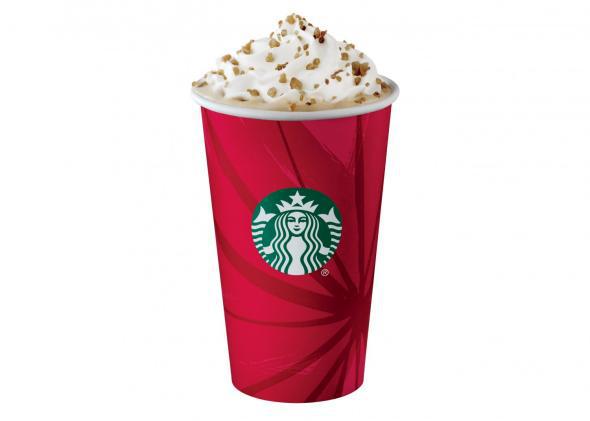When I lived in Paris as a college student, I discovered that jam company Bonne Maman made a product I’d never seen in the U.S.: châtaignes or, more generically, crème de marrons, a velvety, intensely sweet, glossy brown purée of chestnuts. (Châtaigne and marron both mean chestnut.) It was intended to be slathered on bread, like preserves or Nutella, although it was easily sweeter than either of those spreads. I took to eating it by the spoonful; my mouth waters when I remember the gratification of feeling the cool, sugary purée hit my soft palate. (Not coincidentally, I gained around 15 pounds that year.)
Given my bordering-on-fanatical fondness for crème de marrons, I would seem to be the prime audience for Starbucks’ new Chestnut Praline Latte, “a blend of fresh espresso and flavors of caramelized chestnuts, with freshly steamed milk, topped with whipped cream and spiced praline crumbs,” which is rolling into wide release today.
Starbucks has made it clear that the Chestnut Praline Latte—its first new holiday drink in five years—is intended to evoke romantic visions of Europe, and more specifically romantic visions of European Christmas markets. A recent press release cites “narrow cobblestone streets, wooden stalls, the sweet aroma of roasted chestnuts in the air” and says the company saw “an opportunity to bring a taste of Europe to Starbucks [sic] lineup of holiday espresso beverages.” This marks a departure from Starbucks’ extant stable of holiday beverages—the Gingerbread Latte, Peppermint Mocha, and Caramel Brulée Latte—which imitate flavors familiar to most Americans. (The Caramel Brulée Latte is a sure sign that Starbucks has not cared about European authenticity until now: Assuming that name is supposed to be French, proper gender agreement and all, it should be spelled brûlé.)
But the Chestnut Praline Latte actually incorporates traditional French ingredients, and not just sweetened chestnuts. Those “spiced praline crumbs,” as weird as they may sound, are a riff on a standard French dessert garnish, pralin, which is pulverized, sweetened almonds and hazelnuts. (Pralin is related to but distinct from praline, which refers to a French candy of almonds or hazelnuts enrobed in sugar, an American confection of pecans bound with a fudge-like caramel, or a sweet Belgian nut paste used as a filling for chocolates. The world of praline and its derivatives is vast.)
The obvious question is: Will Americans go for an espresso drink incorporating unfamiliar French ingredients? Most Americans are more acquainted with savory chestnut stuffing than with sweet preparations like crème de marrons and candied chestnuts. Does the Chestnut Praline Latte translate?
I tried one this morning, and I’m not sure. If I hadn’t known that the Chestnut Praline Latte was supposed to taste like chestnuts, I doubt I’d have been able to guess the flavoring. (I asked my barista whether the drink contained actual chestnuts; she assured me that it only contained chestnut-flavored syrup.) The latte wasn’t too sweet. It had a pleasant dark caramel flavor, vaguely nutty overtones, and a clean aftertaste. It somehow evoked the scent of a bonfire without tasting smoky. The word that came to mind was—and this is not a word I usually associate with Starbucks—subtle. (The pralin was entirely extraneous and disappeared into the whipped cream within seconds; I don’t know why Starbucks insists on putting sprinkles on every one of its signature drinks, but I would guess it has more to do with the look than the taste.)
Given that it did not inspire a Proustian reaction in me, a crème de marron diehard, I doubt it will inspire a Proustian reaction in most people—even those who are transported every year upon their first sip of Starbucks’ Pumpkin Spice. If you want a distillation of Christmas memories, stick with the Peppermint Mocha. If you want an espresso drink that tastes like sweet chestnuts, order some crème de marrons from Amazon and stir it into your regular latte. But if you want a latte that’s vaguely wintery and not totally cloying, you might like the Chestnut Praline Latte.
